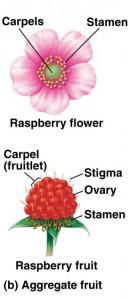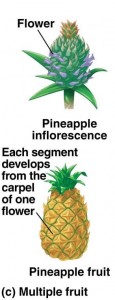YOUR DAILY DOSE OF BOTANY – MAY 2013
Fruit Salad Part IV
Scott Namestnik, snamestnik@orbisec.com
Ready for a final bite of fruit salad? In this column in the past three issues of The Plant Press, we’ve looked at fleshy fruit and dry fruit. One thing that all of the types of fruit that we’ve examined to date have had in common is that they all are simple fruits, or fruits that develop from a single carpel or several united carpels. The carpel is the combined female reproductive organ, consisting of the stigma, usually a style, and the ovary.
When a single flower has more than one carpel but they are not united, the resulting fruit is known as an aggregate fruit. Aggregate fruits can be fleshy or dry. Examples of dry aggregate fruits would be those that form clusters of achenes and those that form clusters of follicles. Clusters of berries or clusters of drupelets form fleshy aggregate fruits. The raspberry (Rubus spp.) is an example of a fleshy aggregate fruit formed from a cluster of drupelets. Things get interesting when the receptacle is incorporated into the aggregate fruit, such as in strawberries (Fragaria spp.). In this case, the fruit is considered an aggregate-accessory fruit. Note that in this example, the fleshy red portion is the receptacle, and the “seeds” on the surface are actually not seeds, but instead are individual fruitlets that each contain a single seed.
 A final type of fruit forms when a cluster of flowers produce fruit that mass together into one conglomerate fruit known as a multiple fruit. Common examples of multiple fruit include mulberries (Morus spp.), Osage orange (Maclura pomifera), and pineapple (Ananus comosus).
A final type of fruit forms when a cluster of flowers produce fruit that mass together into one conglomerate fruit known as a multiple fruit. Common examples of multiple fruit include mulberries (Morus spp.), Osage orange (Maclura pomifera), and pineapple (Ananus comosus).
All of these fruits have developed to provide different reproductive strategies for the plants on which they grow. Consider the reproductive strategy of a plant the next time you bite into a fruit.
If you have a question about flowers and fruits that you would like answered in a future edition of this column, send me an email at snamestnik@orbisec.com. I may not be able to address all requests given the space allotted for this column, but I will answer those that I can.
Click here to see more of Scott’s informative work
<Back to Your Daily Dose of Botany
| Illustrations © 2011 Pearson Education |
